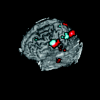Constraint-induced movement therapy for individuals after cerebral hemispherectomy: a case series
- PMID: 19246557
- PMCID: PMC2664995
- DOI: 10.2522/ptj.20070240
Constraint-induced movement therapy for individuals after cerebral hemispherectomy: a case series
Abstract
Background and purpose: This case report describes the feasibility and efficacy of the use of constraint-induced movement therapy (CIMT) in 4 individuals (aged 12-22 years) who underwent cerebral hemispherectomy (age at time of surgery=4-10 years). The aims of this case series were: (1) to evaluate the feasibility of this therapeutic approach involving a shortened version of CIMT, (2) to examine improvements that occurred within the upper extremity of the hemiparetic side, (3) to investigate the feasibility of conducting brain imaging in individuals with depressed mental ages, and (4) to examine changes in the sensorimotor cortex following intervention.
Case description: The patients received a shortened version of CIMT for 3 hours each day for a period of 10 days. In addition, a standard resting splint was used for the unimpaired hand for an 11-day period. Each patient was encouraged to wear the splint for 90% of his or her waking hours. The following outcome measures were used: the Actual Amount of Use Test (AAUT), the Box and Block Test (BBT), and the upper-extremity grasping and motor portions of the Fugl-Meyer Assessment of Motor Recovery (FM).
Outcomes: Immediately after therapy, improvements were found in AAUT and BBT scores, but no improvements were found in FM scores. Three patients underwent brain imaging before and after therapy and showed qualitative changes consistent with reorganization of sensorimotor cortical representations of both paretic and nonparetic hands in one isolated hemisphere.
Discussion: The findings suggest that CIMT may be a feasible method of rehabilitation in individuals with chronic hemiparesis, possibly leading to neuroplastic therapy-related changes in the brain.
Figures




Similar articles
-
Cerebral hemispherectomy: sensory scores before and after intensive mobility training.Brain Dev. 2012 Sep;34(8):625-31. doi: 10.1016/j.braindev.2011.10.012. Epub 2011 Dec 2. Brain Dev. 2012. PMID: 22137579 Free PMC article.
-
Locomotor training remodels fMRI sensorimotor cortical activations in children after cerebral hemispherectomy.Neurorehabil Neural Repair. 2007 Nov-Dec;21(6):497-508. doi: 10.1177/1545968307299523. Epub 2007 Mar 16. Neurorehabil Neural Repair. 2007. PMID: 17369509 Free PMC article. Clinical Trial.
-
Effect of aerobic exercise prior to modified constraint-induced movement therapy outcomes in individuals with chronic hemiparesis: a study protocol for a randomized clinical trial.BMC Neurol. 2019 Aug 15;19(1):196. doi: 10.1186/s12883-019-1421-4. BMC Neurol. 2019. PMID: 31416436 Free PMC article. Clinical Trial.
-
Randomized, multicenter, comparative study of NEURO versus CIMT in poststroke patients with upper limb hemiparesis: the NEURO-VERIFY Study.Int J Stroke. 2014 Jul;9(5):607-12. doi: 10.1111/ijs.12100. Epub 2013 Sep 9. Int J Stroke. 2014. PMID: 24015934 Clinical Trial.
-
Primed low-frequency repetitive transcranial magnetic stimulation and constraint-induced movement therapy in pediatric hemiparesis: a randomized controlled trial.Dev Med Child Neurol. 2014 Jan;56(1):44-52. doi: 10.1111/dmcn.12243. Epub 2013 Aug 21. Dev Med Child Neurol. 2014. PMID: 23962321 Free PMC article. Clinical Trial.
Cited by
-
Constraint-Induced Movement Therapy for Children With Brain Tumors.Pediatr Phys Ther. 2017 Jan;29(1):55-61. doi: 10.1097/PEP.0000000000000331. Pediatr Phys Ther. 2017. PMID: 27984470 Free PMC article.
-
Cerebral hemispherectomy: sensory scores before and after intensive mobility training.Brain Dev. 2012 Sep;34(8):625-31. doi: 10.1016/j.braindev.2011.10.012. Epub 2011 Dec 2. Brain Dev. 2012. PMID: 22137579 Free PMC article.
References
-
- Cook SW, Nguyen ST, Hu B, et al. Cerebral hemispherectomy in pediatric patients with epilepsy: comparison of three techniques by pathological substrate in 115 patients. J Neurosurg. 2004;100(2 Suppl Pediatrics):125–141. - PubMed
-
- Jonas R, Nguyen S, Hu B, et al. Cerebral hemispherectomy: hospital course, seizure, developmental, language, and motor outcomes. Neurology. 2004;62:1712–1721. - PubMed
-
- Harvey AS, Cross JH, Shinnar S, Mathern GW; ILAE Pediatric Epilepsy Surgery Taskforce. Defining the spectrum of international practice in pediatric epilepsy surgery patients. Epilepsia. 2008;49:146–155. - PubMed
-
- de Bode S, Firestine A, Mathern GW, Dobkin B. Residual motor control and cortical representations of function following hemispherectomy: effects of etiology. J Child Neurol. 2005;20:64–75. - PubMed
-
- DeLuca SC, Echols K, Ramey SL, Taub E. Pediatric constraint-induced movement therapy for a young child with cerebral palsy: two episodes of care. Phys Ther. 2003;83:1003–1013. - PubMed
Publication types
MeSH terms
Grants and funding
LinkOut - more resources
Full Text Sources

